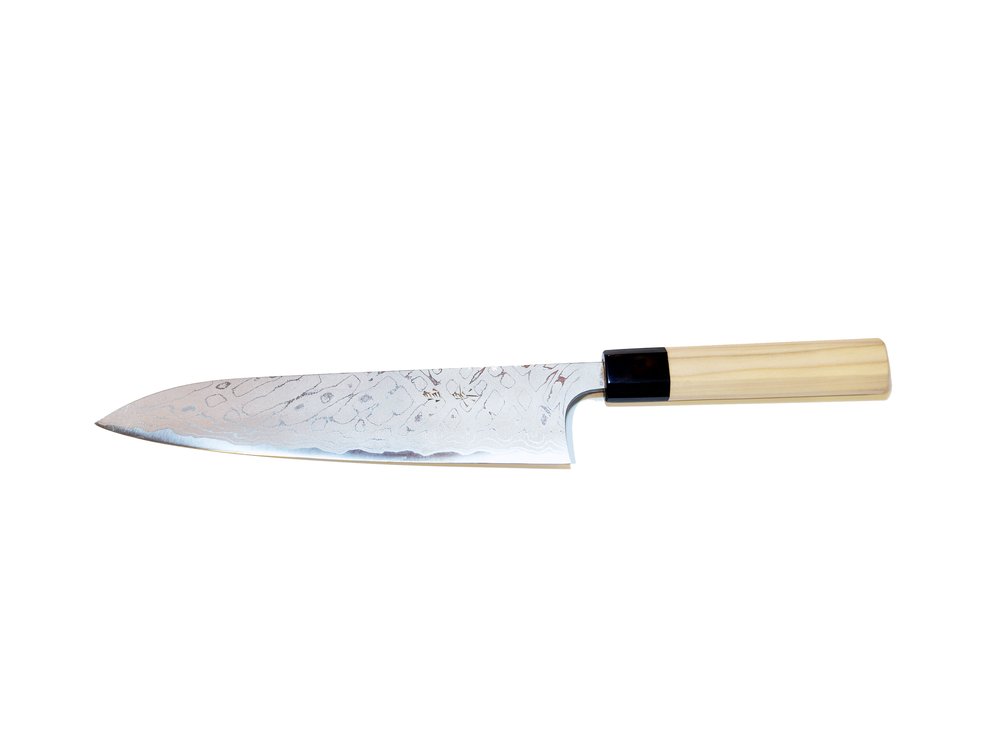Every kitchen deserves a good knife. A quality blade is a necessary tool for a chef, but good knives are hard to find. Most of the blades available today are of terrible quality. They chip, go blunt faster than your shaving blade, and the handle pops off when you cut into a raw steak that didn’t defrost all the way through. But most of the time us men don’t only buy a bad blade, we buy the wrong one.
A friend of mine bought a fancy set of knives for himself, but noticed it was too flexible, and while cutting anything it would start bending towards the other direction. I pointed out that he had bought a whole set of serrated bread knives, pity. While good knives do cost, always pick carefully. People usually go for the branded ones that are good looking, and knives with some celebrity chef’s signature. And then, they buy the wrong blade and ruin it. Men try crushing a chicken bone, use a tile as the cutting board and even use the wrong cutting technique. These can ruin a delicate blade, and the delicate blades are the best. You don’t care much for your knife? Don’t care for cutting techniques? Go ahead, buy a boring mass-market blade. But if you’re looking for efficiency and flair, and know how to treat your knife, quality blade is what you need in your kitchen arsenal.
While buying a knife, I suggest either a Japanese blade or a German one. A Japanese style knife has a thinner blade hence it is sharper, but at the same time needs more care as it can be less robust. German blades are stronger, have thicker blades, need less care but are nowhere near as sharp as Japanese blades. The Japanese blades are unique. Unlike the common knife, which are cut from metal sheets and then processed and sharpened to get a decent blade, many of the knives of the east are hand forged, and delicately hammered out and sharpened.
Now how does one tell what must one look for when selecting a blade to meet your sharp specifications? Where in the world, apart from Japan, can one find a nice ninja-like Japanese blade, forged by blacksmiths who have been practicing the skill for generations? There are a very few outlets to buy from in North America. One of the most exceptional names in Japanese hand-crafted knives is Masakage Knives. Masakage have their craftsmen hard at work in Japan and supply them via various retailers around the globe. The knives are designed by chefs, and make the strongest blades out of select metals.
FactoryTwoFour sought out expert advice on Japanese knives and a connoisseur on the subject was in need. We contacted just the right person who has great passion for knives, Kevin Kent.
“When choosing knife it’s best to buy from a place you trust has expert knowledge and can help you through the process. Find a store that has a large selection, helpful staff and sample knives to let you test drive the knife before buying.”
And Mr. Kent owns such a chain of knife shops, Knifeware, which meets these excellent standards just as he has described. There you get a chance to test out the blades available for sale. Like the start of any good relationship, one must go on a date first. Right now if you wish to try out, or ‘date’, the various Japanese blades at Knifeware you would have to go to one of the various Knifeware shops in Canada, or maybe, soon, a new Knifeware shop in Japan.
“If you don’t have a shop like that near where you live the internet is the next best option. Good suppliers will have a toll free number so you can call any time and talk to an expert to guide you to the perfect knife. The perfect blade for you is just that, perfect for you.”
So what exactly is the protocol to follow when purchasing a knife? Kevin goes on to tell us…
“Everyone has different needs. First question is what kind of steel? Stainless steels are a great option for people who want easy maintenance. They will stay sharp for a good long time and will not rust. Carbon steel however can rust but will stay sharper longer and give a silkier feeling when slicing. Some knives, my favourite, have carbon steel core wrapped with stainless steel. The maintenance issues are less but you are still cutting with carbon. It’s the future! The nest consideration is the handle. Western handles with a full tang and rivets are heavier and super rugged. A traditional Japanese handle is much lighter and the knife will have a forward balance. I prefer Japanese handles. After that it is all about the right size and the looks. I say grab a knife that you think looks great. You are going to be using it everyday after all, you should look forward to cutting with a sexy blade. The size of knife you should buy is the size you currently use the most often. Easy peasy.”


